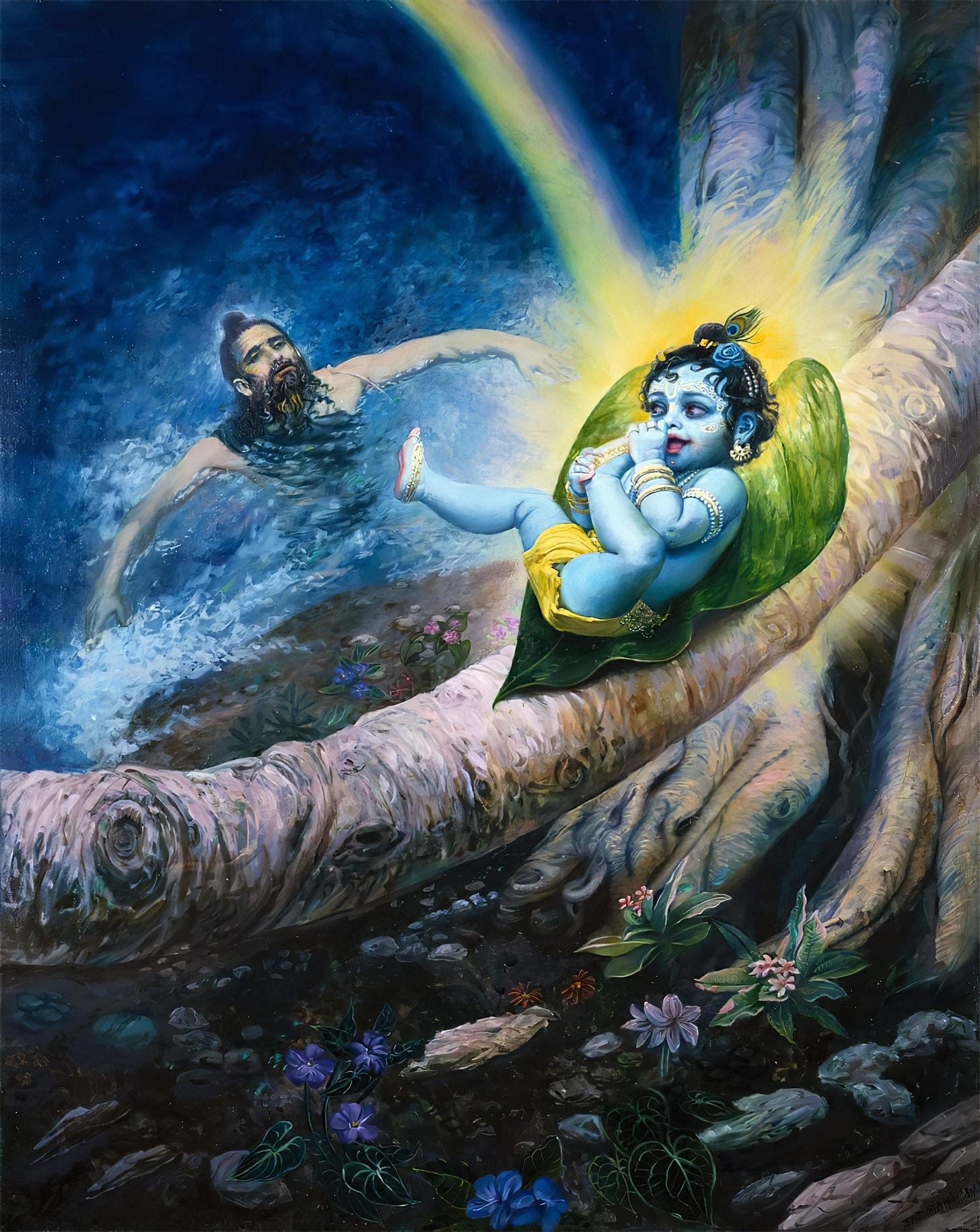The cosmic units of time described in the Vedas
Apart from small units of time, used to measure the time of human beings, the Vedas also describe larger cycles of time, which measure the duration of time of inhabitants of higher planetary systems.
Apart from small units of time, used to measure the time of human beings, the Vedas also describe larger cycles of time, which measure the duration of time of inhabitants of higher planetary systems, many of whom live for many kalpas. This passage of the Srimad Bhagavatam starts with the inquiry of Vidura:
“Vidura said: I now understand the life durations of the residents of the Pitā planets and heavenly planets as well as that of the human beings. Now kindly inform me of the durations of life of those greatly learned living entities who are beyond the range of a kalpa.” (SB 3.11.16)
The Divya-yuga
Satya-yuga lasts for 4,800 celestial years. Each celestial year corresponds to 360 years of our time, and therefore Satya-yuga lasts for a total of 1,728,000 years. During this period, there is a gradual decline in the level of consciousness, which in time leads humanity to the second age in the cycle: Treta-Yuga, or the Silver Age.
During this period, people become interested in economic development. Agriculture becomes very prominent, and society is divided into different classes, with pious kings watching over the well-being of the general population. Most people in this age are still quite pious, and their level of consciousness is sufficient to award them bodies capable of living up to 10,000 years. The preferred method of self-realization in this age is the performance of elaborate Vedic sacrifices.
Treta-yuga lasts for 3,600 celestial years, or 1,296,000 years of our time. Again, there is a gradual deterioration and low qualities become more prominent, leading humanity to the third age: Dvapara-yuga, or the Bronze Age. In this age, about half of humanity is dominated by lust, greed, and other similar qualities. At the start of Dvapara-yuga, people live for 1,000 years, but life expectancy diminishes gradually and by the end of the period is close to 100 years.
Dvapara-yuga lasts for 2,400 celestial years, or 864,000 years of Bhu-Mandala. It’s followed by Kali-yuga, the last era of the cycle, the era we are currently living. According to astronomical calculations, this age started at 3012 BCE, exactly at the time Krsna left this world. The Surya Siddhanta describes a particularly inauspicious alignment of planets that happened at the start of this era. Modern calculations confirm this alignment happened at the described time.
During Kali-yuga, humanity slowly degrades, as beings from the lower realms get the opportunity to take birth on our planet to accumulate a new set of Karma. This is also the shortest of the four eras, lasting for just 1,200 celestial years, or 432,000 years of Bhu-Mandala.
It’s narrated that by the end of this period, the avatara Kalki comes. He destroys the oppressive kings and soldiers who, by that tim,e will be no more than plunderers of the poor citizens, and creates the conditions for the beginning of a new cycle. Under the guidance of great sages from previous ages who wait for the end of Kali-yuga in Badarikāśrama, humanity is restored to its original state, and a new Satya-yuga starts, marking the beginning of a new cycle.
The cycles of Satya-yuga, Treta-yuga, Dvapara-yuga, and Kali-yuga go on cyclically like the seasons of the year. Each complete cycle of four eras is called Divya-yuga, and it lasts for a total of 12,000 celestial years or 4.32 million years of Bhu-Mandala. It may seem like a very long period, but it’s just a moment in the cosmic scale of time. It’s described that the inhabitants of Swargaloka live for 10,000 celestial years (3.6 million years). From there, we can see that not only the living standard but also the perception of time on different planets of the cosmos differ. What’s almost a complete universal cycle for us is just a lifetime for them.
One year in Bhu-Mandala (the intermediate planetary system) equals one day for the demigods. Therefore, one year for the demigods equals 360 years in Bhu-Mandala. Satya-yuga lasts for 4,800 years for the demigods, Tretā-yuga for 3,600 years, Dvāpara-yuga 2,400 years, and Kali-yuga for 1,200 years. Thus, a Divya-yuga, or one complete cycle of four yugas, lasts for 12,000 years of the demigods, or 4,320,000 years in Bhu-Mandala.
The manvantara cycles
With this, we come to the Manvantara, which is the cycle that more directly affects the demigods.
A Manvantara is composed of 71 Divya-yugas and lasts for a total of 852,000 celestial years or 306,720,000 years of Bhu-Mandala. The events at the end of a Manvantara are much more dramatic than the events at the end of Kali-yuga, resonating all over the cosmos.
All the Devas, led by Manu, stay in their posts for the period of a single Manvantara. When the period is concluded, they are promoted to Maharloka and a new Manu, as well as a new generation of demigods, take their places. During this time, there are many disturbances in the universe, and it takes some time until things get back on track. During this period, life on most planets ceases almost completely, and everything starts again with the advent of a new Manu, who receives the mission of repopulating the universe with all the different species of life. This period of transition is called Manvantara-sandhya, and it lasts for 1.728 million years.
71 Divya-yugas, or complete cycles of four yugas, form a Manvantara (306,720,000 years, or 852,000 years of the demigods), and 14 Manvantaras, together with their Sandhyas form a day of Brahma (4.32 billion years). The same is the duration of his night.
1 Divya-yuga (set of 4 yugas) = 4.32 million years (12,000 celestial years)
1 Manvantara (71 Divya-yugas) = 306.72 million years (or 852,000 celestial years)
1 Kalpa (a day of Brahma) = 4.32 billion years
360 of such days and nights form one of his years, and 50 of such years form a Parardha. Brahma lives for two of such parardhas and thus his life is divided into two halves. As mentioned in SB 3.11.34: “The one hundred years of Brahmā’s life are divided into two parts, the first half and the second half. The first half of the duration of Brahmā’s life is already over, and the second half is now current.”
With this, we enter into the really large units of time:
2 Kalpas (a day and night of Brahma) = 8.64 billion years
1 Parardha (50 years for Brahma) = 155,52 trillion years
2 Parardhas = 1 Maha-kalpa (311,04 trillion years)
1 Maha-kalpa (a life of Brahma) = 1 mimesa for Lord Maha-Vishnu
The total duration of the life of Brahma equals just one mimesa (about half a second) for Lord Maha-Vishnu, which gives us an idea of the insignificance of our limited lifespans in this material world. One could use these formulas to calculate the length of the ksanas, kasthas, laghus, and daṇḍas of Maha-Vishnu, but I believe what we saw up to here already makes the point.
Similarly, our universe is covered by seven layers (earth, water, fire, air, ether, mahat-tattva, and false ego). The first layer has 10 times the diameter of the universe itself, and each successive layer has 10 times the diameter of the preceding layer. All the universes clustered together appear like atoms in a huge combination that are constantly created and destroyed, following the cycles of exhalation and inhalation of Maha-Vishnu. Thus, not only do we live for an insignificant amount of time, but we are also incredibly small on the universal scale.
The life of Brahma
Just like us, Brahma lives for 100 years. The difference is that his years are a little longer than ours.
The life of Brahma is divided into two halves, or parardhas. The first half is already over, and now we are in the second half. The first day of the life of Brahma was called Brāhma-kalpa (the millennium Brahma appeared), and the second Pādma-kalpa (the millennium the first creation happened). The current millennium is called the Vārāha millennium (because that’s the millennium Lord Varaha appears) or Pādma-kalpa (because in this millennium a new creation takes place following the complete destruction at the end of the first half of the life of Brahma). The whole life of Brahma equals just one nimeṣa (half a second) for Lord Maha-Vishnu.
Although time controls everything that is material, time is under the complete control of the Lord. Similarly, time controls everyone who is under the body’s conception of life, from lower animals to demigods, but it doesn’t control pure devotees of the Lord, who live in the transcendental platform.
The size of the universe
“This phenomenal material world is expanded to a diameter of four billion miles, as a combination of eight material elements transformed into sixteen further categories, within and without, as follows.
The layers or elements covering the universes are each ten times thicker than the one before, and all the universes clustered together appear like atoms in a huge combination.” (SB 10.11.40-41)
Bhu-mandala, the early planetary system, is just four billion miles in diameter, a size that is similar in scale to the size of our solar system according to modern astronomy. We can’t access the other parts of Bhu-mandala because these realms exist in higher dimensions, but it is described that qualified human beings from previous ages were able to access the different realms that comprise it. However, when we speak about going up, to the higher planetary systems, the trip can’t be completed by just traveling in the physical plane: it demands a change of consciousness. Only someone who has a level of consciousness similar to the demigods and great sages can visit their planetary systems. It is described that Arjuna could visit the celestial planets and even go all the way to the causal ocean together with Krsna. We can understand that it was possible because Arjuna is a pure devotee, but for general people, this is not possible.
Apart from the universe created by Brahma, our universe also includes the coverings of elemental earth, water, air, fire, sky, ego, and mahat-tattva. Each covering is ten times larger than the previous. According to the measurements given in the Puranas, the coverings extend to a scale similar to what in modern astronomy is calculated as the size of our galaxy, but due to the multidimensional nature of the Vedic universe, it may extend much further than this, covering all the observable universe and beyond.
Because it demands a shift in consciousness, the distance to the higher planets when calculated in terms of physical distance becomes practically infinitely big. Our universe is simultaneously relatively small (the four billion miles of Bhu-Mandala) and infinitely big, including all the different stars and galaxies we see in the sky. All of this, however, is not the complete material manifestation. There are millions of other universes, clustered together like atoms.
Read also:
The nature of material time
Time is the energy that puts the whole material manifestation in motion. The influence of time leads to the transformations that both create and destroy all living beings and material objects. Due to the influence of time, everything is created at a certain point due to certain transformations, and these transformations continue until death or destruction. Because of time, everything material has a beginning and also an end, just like the universe itself. Everything spiritual, however, passes through no transformations and thus has no beginning and no end.



